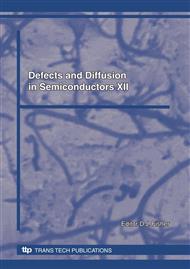[1]
J. A. Aramburu, M . T. Barriuso, P. García Fernández, and M. Moreno: Adv. Quant. Chem., 44 (2003) 445.
Google Scholar
[2]
J. M. Spaeth and F. K. Koschnick: J. Phys. Chem. Solids, 52 (1991) 1.
Google Scholar
[3]
D.G. DeWit: Coordination Chemistry Reviews, 147 (1996) 209.
Google Scholar
[4]
F. Callens, H. Vrielinck, P. Matthys, M. Zdravkova, H. Vercammen, and D. Schoemaker: J. Appl. Phys., 84 (1998) 422.
DOI: 10.1063/1.368044
Google Scholar
[5]
H. Vercammen, D. Schoemaker, H. Kass, E. Goovaerts, A. Bouwen, H. Vrielinck, and F. Callens: J. Appl. Phys., 84 (1998) 428.
DOI: 10.1063/1.368045
Google Scholar
[6]
H. Vercammen, D. Schoemaker, B. Brait, F. Ramaz, F. Callens: Phys. Rev. B, 59 (1999) 11286.
Google Scholar
[7]
H. Vrielinck, F. Callens, M. Zdravkova, P. Matthys: J. Chem. Soc. Faraday Trans., 94 (1998) 2999.
DOI: 10.1039/a803042a
Google Scholar
[8]
J.J. Chen and M.L. Du: Physica B, 215 (1995) 260.
Google Scholar
[9]
J.J. Chen and M.G. Zhao: Phys. Stat. Sol. B, 143 (1987) 647.
Google Scholar
[10]
G.L. McPherson, J.J. Kistenmacher, G.D. Stucky: J. Chem. Phys., 52 (1970) 815.
Google Scholar
[11]
M. Hohne, M. Stasiw and A. Watterich: Phys. Stat. Sol., 34 (1969) 319.
Google Scholar
[12]
J. Busse: Phys. Stat. Sol., 3 (1963) 1892.
Google Scholar
[13]
R.M. Macfarlane: J. Chem. Phys., 47 (1967) (2006).
Google Scholar
[14]
R.M. Macfarlane: Phys. Rev. B, 1 (1970) 989.
Google Scholar
[15]
S.Y. Wu, W.Z. Yan, X.Y. Gao: Spectrochim. Acta A, 60 (2004) 701.
Google Scholar
[16]
R.C. Weast: CRC Handbook of Chemistry and Physics (CRC Press, Boca Raton, 1989) p. B196; F187.
Google Scholar
[17]
E. Clementi and D.L. Raimondi: J. Chem. Phys., 38 (1963) 2686.
Google Scholar
[18]
E. Clementi, D.L. Raimondi and W.P. Reinhardt: J. Chem. Phys., 47 (1967) 1300.
Google Scholar
[19]
C.K. Jørgensen: Absorption Spectra and Chemical Bonding in Complexes (Pergamon Press, Oxford, 1962).
Google Scholar
[20]
Z.Y. Yang, C. Rudowicz and J. Qin: Physica B, 318 (2002) 188.
Google Scholar
[21]
M.G. Zhao, J.A. Xu, G.R. Bai and H.S. Xie: Phys. Rev. B, 27 (1983) 1516.
Google Scholar
[22]
J.S. Griffith: The Theory of Transition-Metal Ions (Cambridge University Press, London, 1961).
Google Scholar
[23]
G.L. McPherson, R.C. Kach and G.D. Stucky: J. Chem. Phys. Vol. 60 (1974), p.1424.
Google Scholar
[24]
M.T. Barriuso, J.A. Aramburu, and M.J. Moreno: J. Phys.: Condens. Matt. Vol. 14 (2002), p.6521.
Google Scholar
[25]
S. Fraga, K.M.S. Saxena, and J. Karwowski: Handbook of Atomic Data (Elsevier Press. New York, 1976).
Google Scholar
[26]
G.L. McPherson and W.M. Heung: Solid State Commun. Vol. 19 (1976), p.53.
Google Scholar
[27]
G.L. McPherson, R.C. Kach, and G.D. Stucky: J. Chem. Phys. Vol. 60 (1974), p.1424.
Google Scholar
[28]
M. Hohne, M. Stasiw, and A. Watterich: Phys. Stat. Sol. Vol. 34 (1969), p.319.
Google Scholar


